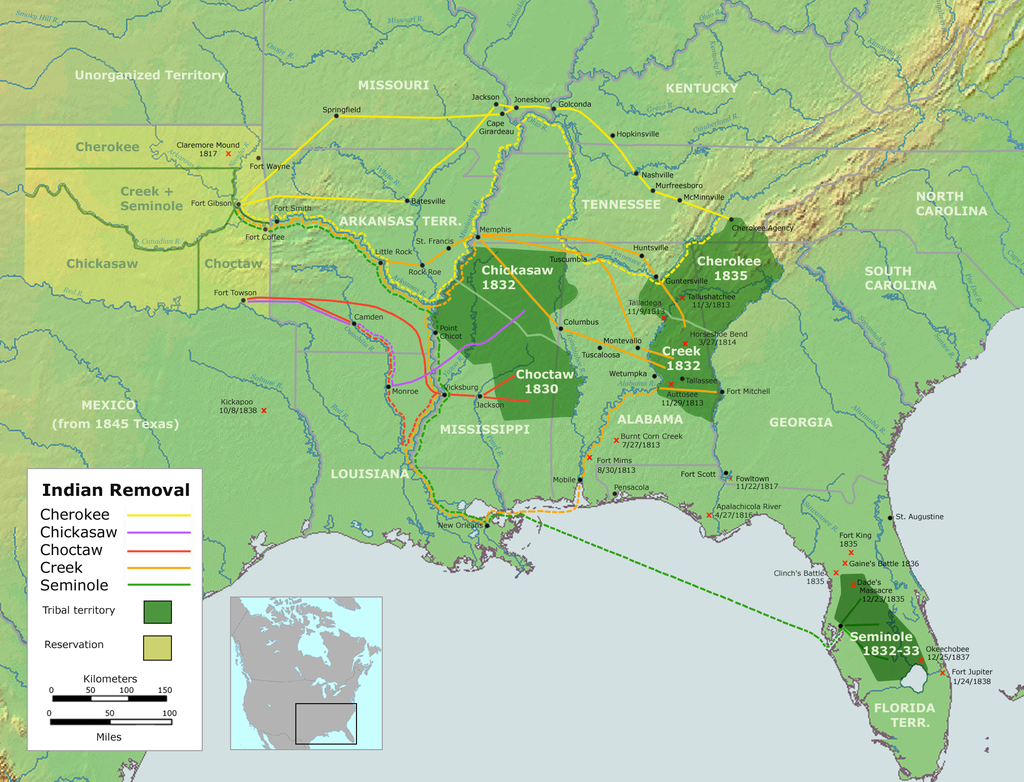
Trail Of Tears
Wikipedia
http://en.wikipedia.org/wiki/Trail_of_Tears
Diane Rehm: President Andrew Jackson, The Cherokee Trail Of Tears & The Great Land Grab
President Jackson, the Supreme Court, and Indian Removal
In the southeastern United States the Choctaws, Cherokees, Creeks, Chickasaws and Seminoles were known as the “Five Civilized Tribes.”
Though they had ceded large blocks of their lands after the War of 1812, they continued to live on their homeland in the Southeast. These five tribes adopted many Euro-American practices including clothing and house styles, had welcomed white missionaries and established farms and business, and had even modeled their own governments after white institutions. The Cherokee Nation had a constitution similar to the U.S. Constitution.
One purpose Jefferson saw for the Louisiana Purchase land was as a home to eastern tribes who continued their nomadic ways. But the five tribes had adopted white practices and thus did not need to move west of the Mississippi to practice traditional hunting and gathering. They could continue to live on their lands in the southeast if only whites would stop trespassing. The southeastern states passed laws invalidating federal treaties that established Indian claim to their lands.
In 1829 when gold was discovered on Cherokee land in north Georgia in 1829, over 3,000 whites invaded that land, trampling Cherokee property and crops. The Cherokees appealed to Georgia's courts to no avail and then the Georgia legislature passed a law prohibiting Cherokees from prospecting for gold on their own land. Both the Articles of Confederation and the Constitution granted to the federal government not the states the responsibility for Indian policy.
But Andrew Jackson, a westerner and known Indian fighter (see the Battle of Horseshoe Bend during the War of 1812) supported the states and urged Congress to provide for the removal of Indians from the southeast. Congress in 1830 passed the Indian Removal Act that appropriated funds and authorized the use of force if necessary to move the southern tribes west. Most of the Choctaws moved west in 1830.
The Creeks resisted but the last were forcibly moved in 1836 and the Chickasaws in 1837.
The Cherokees, however, resisted and sought protection through the federal courts. Remember from your reading of the Constitution that Article III set up the Supreme Court and gave that court the power to hear all cases "arising under this Constitution" (Art. III, Sec. 2). In two cases commonly combined and called the Cherokee Cases decided in 1831 and 1832, the Supreme Court ruled that the Cherokees were a "domestic dependent nation" and as such could not be forced by a state to give up their lands unwillingly.
In other words, the Supreme Court recognized the sovereignty of the Cherokee Nation. President Jackson famously said about Chief Justice John Marshall's ruling: "John Marshall has made his decision. Now let him enforce it."
The President not the Supreme Court. Jackson essentially said that he would not enforce the Court's decision and he did not. Despite their efforts to work through the courts and the courts' support of their position, the Cherokees were forcibly removed from their home. In 1838 a reluctant U.S. Army of 7,000 rounded up the Cherokees and drove them west along what became known as the "Trail of Tears."
As many as 4,000 of the 16,000 Cherokees died along the way. Here is a map of the removal of southeastern Indians.

http://en.wikipedia.org/wiki/Trail_of_Tears#/media/File:Trails_of_Tears_en.png
Today the Trail of Tears is a National Historic Trail that commemorates the removal of the Cherokee. The trail follows about 2,200 miles and traverses portions of nine states. This links to the National Park Service home page for the Trail of Tears National Historic Trail:
http://www.nps.gov/trte/TRTE/home.htm
WSBCTC 3 ©Susan Vetter 2008, rev. 2011
No comments:
Post a Comment